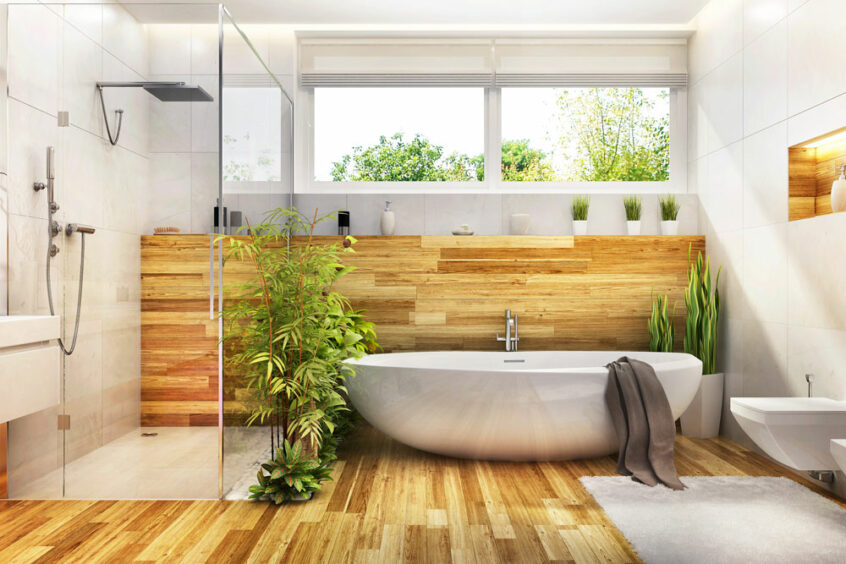“Engineered wood” may sound like it’s something out of the future, but this trusted floor type has actually been around since the 1960s. In fact, engineering wood flooring was first invented as a way to easily cover the surfaces of structures that were built on concrete slabs and may not have been receptive to traditional flooring.
Since this time, homeowners and contractors alike have applauded the existence of engineered wood flooring thanks to its durability and ease of installation. Engineered wood flooring also has a reputation for being rather moisture resistant, thanks to the fact that they are made up of multiple layers of hardwood and plywood, which differs greatly from regular hardwood flooring.
Given this moisture resistance, it would make sense that many people would wonder whether or not it is appropriate to just engineered wood flooring in the bathroom. Let’s have a look:
Is it Okay to Use Engineered Wood in a Bathroom?
In short, yes — for the most part. But let us elaborate.
You do not see regular hardwood floors in bathrooms very often, and there are many reasons for this. For one thing, moisture is incredibly hard on hardwood and can lead to its quick deterioration. Even if you do not deal with frequent spills from your baths and showers, simply having baths and showers inevitably results in a moist environment, which is no friend at all of the traditional hardwood floors.
Engineered hardwood floors, however, will not meet such a disastrous fate in a moist environment. The reason for this is that, unlike standard hardwood, engineered wood comes with extra layers of plywood that do a decent job of protecting the wood itself from moisture.
However, if you are going to use engineering wood in your bathroom, you should be aware that it is not the most trustworthy choice. It is ideal if you have a spacious room with a window that opens to allow for airflow. It should also ideally be a room that does not receive a high amount of foot traffic.
As you can see, considering the number of variables that must exist in order for engineered wood to be a successful bathroom floor material, there is a reason why ceramic flooring tiles still remain the most popular choice for bathroom flooring materials.
However, even with these considerations in mind, there are many homeowners who swear by the appearance and experience of using engineered wood flooring. Let’s take a look at why.
The Benefits of Engineered Wood in a Bathroom
1. Beautifully Aesthetic
Bathrooms are not usually known for being the warmest and welcoming rooms in our homes, though it would make sense if they were. After all, we all spend a considerable amount of time in our bathrooms. The uncommon look of wooden floors in a bathroom adds a homey appearance and a kind of coziness that you didn’t know you were missing in the most utilitarian room in your home.
2. Easy Cleaning
One of the most convenient things about engineered wood flooring is how easy it is to clean. It is safest to use hardwood cleaner and a dry mop.
4 Ways to Keep Your Engineered Wood Floor Safe From Moisture
1. Use Protective Rugs
Who doesn’t live a good bath mat? Not only does this accessory help add to the design of your bathroom, but it also helps to protect your flooring from the brunt of a water spill.
2. Clean Up Spills
“Clean up all spills immediately” isn’t just good safety advice — it’s also advice that could go a long way in protecting the integrity of your floors made of engineered wood.
3. Keep on Top of Bathroom Problems
If you sense that your bathroom or toilet is suffering from an issue, it is in your best interest that you have the problem examined immediately. Failing to do so could result in harmful leakage or condensation.
4. Install a Fan or Crack a Window
If you want to keep the moisture in your bathroom at a minimum, then it’s important that you keep ventilation moving as freely as possible. Your floors will thank you!
If you think that engineered wood flooring might be the right option for you, take a visit to the King of Floor’s large showroom in Surrey. We have just what it takes to build the bathroom of your dreams.
🔍 Explore Our Collections
Buy direct & save. 85,000 sqft MEGA WAREHOUSE. Over 300 products in stock!
Visit our showroom today for unbeatable prices and quality products!

